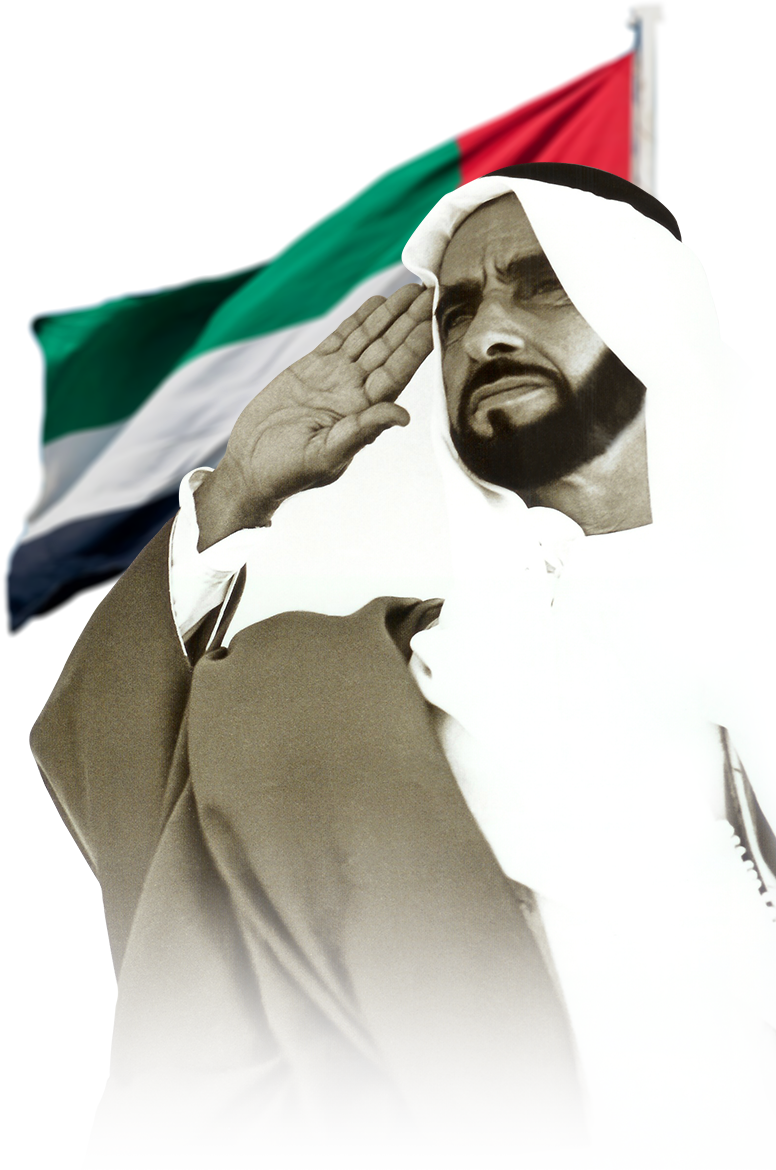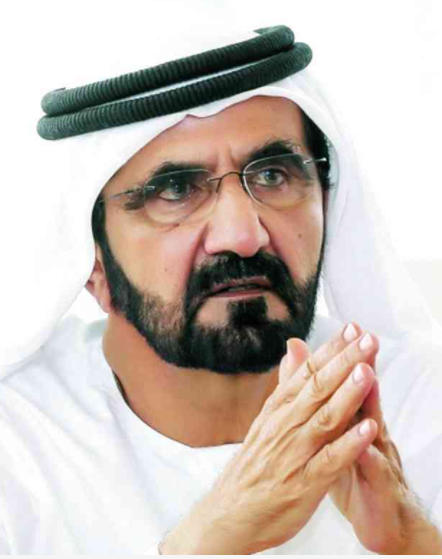Kings & Founder
 DOB: May 6, 1918
DOB: May 6, 1918
The founder of the UAE (1918- 2004)
He is credited as the founding father and the principal driving force behind the formation of the UAE, uniting seven emirates. He was also the ruler of Abu Dhabi from 1966 until his death After the late Sheikh Zayed bin Sultan Al Nahyan became the Ruler of Abu Dhabi in 1966, he had a vision of creating a union to catalyze development just as the other developing nations. Sheikh Rashid bin Saeed in Dubai, who was Ruler since 1958, had a similar vision. A shared vision between the two leaders translated into a federal union between Dubai and Abu Dhabi after the historical meeting in Samha – located on the border area between the sister emirates – on 18th February 1968.
The Dubai-Abu Dhabi Federal Union opened new doors for the establishment of a wider union driven by the shared vision of both Sheikh Zayed and Sheikh Rashid. Ultimately, and after hard work of communications and negotiations, on 18th July 1971, six of the Trucial States (Dubai, Abu Dhabi, Sharjah, Ajman, Umm Al Quwain and Fujairah) decided to form a state under one banner. On 2nd December 1971, the establishment of the United Arab Emirates was announced. Ras Al Khaimah joined the union on 2nd December 1972 when the late Sheikh Zayed bin Sultan raised the UAE flag for the first time. UAE becomes 132nd member of the United Nations.
As a new state, the United Arab Emirates joined the League of Arab Nations on 6th December 1971 and then became the 132nd country to join the United Nations on 9th December 1971. The UAE was a founding member of the Islamic Conference Organisation in the 1970s. Abu Dhabi, capital of the UAE, hosted a historical meeting in 1981 that saw the establishment of the Gulf Cooperation Council which includes UAE, Oman, Qatar, Bahrain, Kuwait and Kingdom of Saudi Arabia.
 DOB: July 15, 1949
DOB: July 15, 1949
On 4th January 2006, His Highness Sheikh Mohammed bin Rashid Al Maktoum became the Ruler of Dubai following the death of Sheikh Maktoum bin Rashid Al Maktoum during a visit to Australia.
On 5th January the members of the UAE Supreme Council elected Sheikh Mohammed the UAE Vice-President. On 11th February 2006 UAE President His Highness Sheikh Khalifa bin Zayed Al Nahyan nominated Sheikh Mohammed for the position of UAE Prime Minister; the Supreme Council approved this nomination. Sheikh Mohammed and the members of his Cabinet took their oaths in front of Sheikh Khalifa at Al Bateen Palace in Abu Dhabi.
On 4th January 1995, Dubai and the UAE awoke to groundbreaking news splashed in banner headlines in Arabic and English that the newspapers. The previous day the Dubai Ruler, Sheikh Maktoum,had signed two decrees that would have a dramatic effect on the future of the emirate. One appointed Sheikh Mohammed bin Rashid as Crown Prince of Dubai. The second recognized Sheikh Hamdan bin Rashid as Deputy Ruler of the emirate. Sheikh Mohammed later commented: “I do not know if I am a good leader, but I am a leader. And I have a vision. I look to the future, 20, 30 years. I learned that from my father, Sheikh Rashid. He was the true father of Dubai. I follow his example. He would rise early and go alone to watch what was happening on each of his projects. I do the same. I watch. I read faces. I take decisions and I move fast; full throttle.”

DOB : November 14, 1982
On Friday, 1st February 2008, the Vice-President and Prime Minister of the UAE, in his capacityas Ruler of Dubai, His Highness Sheikh Mohammed bin Rashid Al Maktoum, issued a decree appointing his son Sheikh Hamdan bin Mohammed bin Rashid Al Maktoum, as Crown Prince of Dubai.
On Friday, 1st February 2008, the Vice-President and Prime Minister of the UAE, in his capacity as Ruler of Dubai, His Highness Sheikh Mohammed bin Rashid Al Maktoum, issued a decree appointing his son Sheikh Hamdan bin Mohammed bin Rashid Al Maktoum, as Crown Prince of Dubai. The decree was effective from the date of issuance. Sheikh Mohammed also issued a decree, naming his brother Sheikh Hamdan bin Rashid Al Maktoum and his son Sheikh Maktoum bin Mohammed bin Rashid Al Maktoum as Deputy Rulers of Dubai Sheikh Hamdan is Sheikh Mohammed’s second son, and he is well known as ‘Fazza’.
History Of Dubai

The ancient history of Dubai is not accurately recorded, although excavations uncovered the presence of human settlements that date back to approximately 4,000 years. Hundreds of artifacts, housed in the Dubai Museum, point to civilizations that inhabited the area between the second and third B.C. Archaeologists have successfully uncovered hundreds of burial sites of different shapes and sizes in Al Qusais. Significant sites in the UAE include the Hatta village site dating back to approximately the third century B.C. whereas Jumeirah is considered by historians to be a familiar landmark in Islamic history, especially in the First Islamic Age. Pottery, Islamic-style decorations, and coins have been found. Al Fahidi Fort was built in several phases. The oldest tower was built around 1799 and is believed to be the oldest building in Dubai that still exists today. The fort was used to guard the landward approaches to the town. In 1971 and after undergoing maintenance works that lasted for three years, Al Fahidi Fort was transformed into a museum that displays a rich collection of artifacts that create a realistic image of what was day-to-day life really like before the discovery of oil in this region.
The earliest recorded mention of Dubai is in 1095, in the “Book of Geography” by the Andalusian-Arab geographer Abu Abdullah al-Bakri. The Venetian pearl merchant Gaspero Balbi visited the area in 1580 and mentioned Dubai (Dibei) for its pearling industry. Dubai was referred to as Al Wasl by British historians. Few records pertaining to the cultural history of the UAE or its constituent emirates exist and because of the region’s oral traditions, folklore and myth were not written down. According to Fedel Handhal, a researcher in the history and culture of the UAE, the word Dubai may have come from the word Daba. There are several theories as to how Dubai was named. One theory is that the word Dubai is a combination of the Farsi words for two brothers, the latter referring to Deira and Bur Dubai. Others believe that ‘Dubai’ was so named by people who considered its souq a smaller version of a thriving market named ‘Daba’. Another possibility is that the name came from a word meaning money – people from Dubai were commonly believed to have money because it was a prosperous trading center.
In the 18th century, Dubai was a small fishing and trading village inhabited by members of the Bani Yas. The Al Maktoum family settled in Dubai in 1833. As the population grew, Dubai branched into three distinct areas: Deira was the largest and the main commercial center. On the western bank, Bur Dubai and Shindagha were separated by a wide stretch of sand called Ghubaiba, which would flood during high tide. Shindagha, situated on a narrow strip of land separating the sea from the creek, was the smallest area and the main residential district. The ruling sheiks traditionally lived here and the late Sheikh Saeed’s house is still standing. Shindagha was probably the site of the original Bani Yas village. Crossing the creek meant a long and arduous journey around the end of the creek or a ride in an abra, a small wooden boat that ferries passengers to this day. Abras were also used to transport people to ships. The arabs have become a huge tourist attraction. Deira’s souk, the town’s public market, was lined with narrow, covered passageways. With 350 shops of commodities from around the world, it was the largest market in the region. Many of the craftsmen in the souk had no shop but worked on a vacant piece of ground as close as possible to their clients. They were known by name, and the cry would go around the souk, Where is Hassan the mattress-maker?? until it reached him and he was able to make contact with the potential client. A mattress maker’s creation was vulnerable to visits from passers-by, who might stop to pray on it or simply to rest and chat.? Prior to the introduction of electricity in 1952, kerosene lamps or candles were
used for lighting, and charcoal, imported from the interior of Oman, was used for cooking and making coffee. Sweet water came from wells around Dubai. The majority of the inhabitants lived in barastis, huts constructed from palm fronds. Extended families dwelled in compounds amid the compounds of relatives. Houses were constructed of gypsum from the salt marshes at the end of the creek and coral stone. The town’s highest points were the wind towers of the coral stone houses, the watchtowers, and Al Fahidi Fort. Wind towers were used for ventilation — a house would cool as water on the floor beneath the tower evaporated. Built in 1799, the Fort is Dubai’s oldest surviving structure and it has served as the seat of government, the Ruler’s residence, and a jail. With a thriving port and market, Dubai’s residents enjoyed a higher standard of living than their neighbors in the region.
Content Updated Soon !
Content Updated Soon !
Major Contributors
Content Update Soon !
Do You Also Know
Content Update Soon !

